The House Printing Telegraph
by Bob Harding
Reprinted from "Crown Jewels of the Wire", December 1990, page 13
A couple of years ago I was fascinated by Ginny Plunkett's story about the
insulators they had found on a early Ohio railroad line in the mid-70's. She
described an odd glass insulator that was fastened to the pole tops and covered
with an iron shell. It was discovered to be an insulator designed by Royal E.
House who invented it for use on his printing telegraph lines.

The Plunkett
family found many pieces before realizing that it truly was an insulator. The
large teal green shards were oddly threaded on the inside as well as the
outside. They found some pieces still laying in parts of the heavily rusted iron
shell. After discovering its true identity they were able to find enough shards
to get a good idea of what the whole insulator looked like.
I made a trip to the
line shortly after I heard the story but was quickly discouraged by the thick
undergrowth. I set aside my thoughts of the House insulator soon afterward.
During the next year or so my interest in threadless hunting increased
greatly. I found myself roaming Ohio, West Virginia and Michigan in search of
abandoned railroads and threadless. In the fall of 1987 Rob Lloyd and I embarked
on a three day search of some lines we had researched. We walked several lines
during that period and for the first two days we found nothing earlier than a
spiral groove (CD 147).
As the noon sun glared down on us that last day we found
another dead end. We decided to checkout one more line before giving up. An hour
later we had finally found the abandoned railroad bed. We followed it for awhile
in the car to get out of town. About a mile or so out of town the country road
followed parallel to the track. The thin 10-yard section of ground between the
bed and the road had recently been plowed. Simultaneously Rob and I both spotted
a glint of aqua from amongst the furrows. Rob jumped out of the car to pick up
the glass. He held up a large piece of glass and mouthed the word "WADE".
| (Below) One of the improvements in the House Printing Telegraph was a treadle
placed under the instrument which replaced the hand crank. The operator was able
to work the ma chine without an assistant.
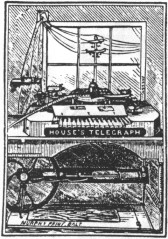
|
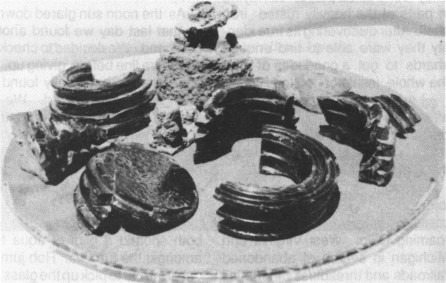
Some of the House insulator pieces found by the Plunkett family.
We walked the small stretch of plowed field and found many more pieces of Wade,
McKee, and unembossed CD 731's. I pulled an olive green piece
from the ground, it was a piece of the "House" insulator. The rest of
the day produced several more pieces of the House insulator in different colors.
At this point we devoted much energy and effort to research as well as walking
the line. As a result, we have found a good deal of pieces in a striking variety
of colors. Bob Roosevelt also accompanied us on some of these trips. He has also
found several "House" pieces on a line in north central Ohio.
Royal E.
House was born in Vermont in 1814. As a young child he moved to Pennsylvania. He
was always interested in science and mechanics. He moved to Buffalo to live with
relatives and study law. Soon law took a back seat to electricity.
Mr. House was
a self-educated man and spent nearly six years perfecting his telegraph
instrument. He was finally granted his patent in 1848 after some dispute since
many of the specifications were in direct competition with Samuel F. B. Morse's
telegraph. When his patent was awarded it was given an earlier date of April
18,1846. He was given an additional patent on December 28, 1852 for improvements
to the telegraph.
The House printing telegraph was unique in the fact that it
used keys similar to those of a piano and printed regular Roman alphabet letters
on a strip of paper. A detailed account on the workings of this instrument can
be found in The Electromagnetic Telegraph by Lawrence Turnbull, M.D., 1853.
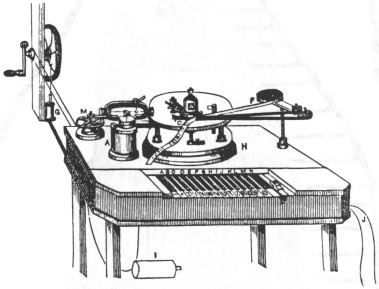
(Above) A composing and printing machine were required at every station. The
House composing machine was a three foot wide mahogany frame, two inches in
height and six to ten inches in depth and contained the keyboard. The various
parts of the printing machine are on top of the case. All were powered by a
manual crank. |
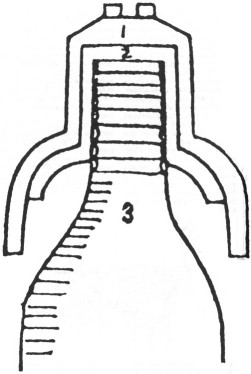
1 - Outer shell of iron on House insulator
2 - Glass liner
3 - Pole

Pieces of the glass liner portion of the insulator
showing the threading on
the inside and outer walls.
Shortly after its inception, lines were constructed across the East. The New
York & Mississippi Valley Printing Telegraph Company contracted lines on
several railroads by 1854. These railroads included the Cleveland & Toledo,
Michigan Southern and Northern Indiana and the "Big Four".
Pieces
have been found on each of the above railroads. Colors include aqua, green aqua,
rootbeer amber, teal-aqua, dark teal green, cobalt, sapphire blue, olive, yellow
olive, jade milk, yellow Depression green. The Plunketts have found several
pieces of the cast iron shell as well as a complete top. Rob Lloyd, Bob
Roosevelt and I have done extensive work with a metal detector along a different line. With literally hundreds of hours of work on
several sections of the line, we still have been unable to find any of the iron
shell. We have been lucky enough to find a couple of the washers that held the line to the top of the insulator. It is my theory that
the insulators were carried off when the line changed over to the Wade
insulators.
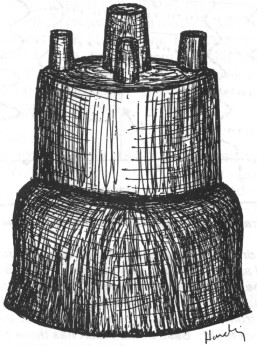
The iron-clad House insulator (Drawing by Bob Harding)

Cut-away drawing and measurements of the House Insulator
At the top of the drawing is the metal washer from a side view and a top
view; The metal sheath had four small posts on the top and one larger middle
post; The inside wall of the metal sheath had only two projections which secured
the threading of the glass insert; Mold line on the glass insert runs from the
base to the dome and would indicate manufacture in a three piece mold; Base of
the insert has three corrugated rings; Inside of the glass insert has threads
that approximate exterior insert threading; Top of glass insert is solid glass
and is about 1/2" in thickness and has a 3/4" button effect in the
middle of the underside.
|
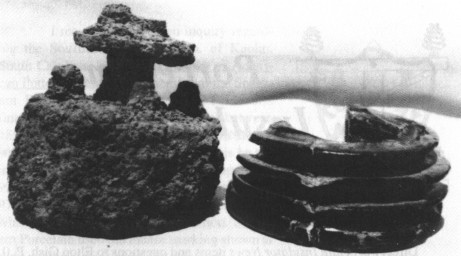
(Left) Top of the iron cap with washer position
on middle post; (right) part
of glass liner
The insulator itself consisted of a glass cap about five inches in diameter,
having a course thread cut inside and out. This glass cap was threaded and
cemented into a bell-shaped iron cap about three or four pounds in weight,
which projected an inch below the lower edge of the glass and protected it from
being broken. The insulator was fitted with much care to the top of the pole and
covered with paint or varnish. The wire was held to the top projec tions by a special washer.
The approved
manner of line installation was with poles 20 to 30 feet in height, set 5 feet
deep, measuring nine inches in diameter at the base and tapering to four and one
half inches at the top. Poles were installed approximately fifteen rods apart.
Thirty Groves batteries were required to carry the current 100 miles.
| Some House Lines: |
|
| New Jersey Magnetic Telegraph (1849) |
Philadelphia-New York City |
| Boston and New York
Telegraph |
Boston - New York City |
| Mississippi Valley Printing Telegraph |
Cleveland - St. Louis |
| Washington Printing Telegraph |
New
York - Washington, D.C. |
Resources:
Digest of Ohio History - pp.240-245
The Electromagnetic Telegraph - Lawrence Turnbull, M.D.
History, Theory and Practice of the Electric Telegraph,
George B. Prescott, 1864
Research and Photos: Elton Gish
Research and Field Work: The Plunkett Family,
Robert Roosevelt, Robert Lloyd, Robert Harding
| 